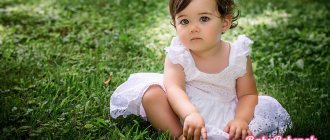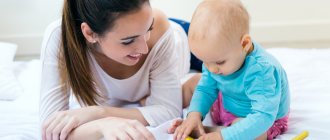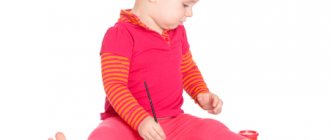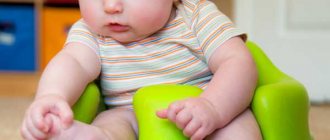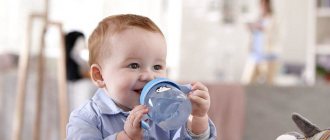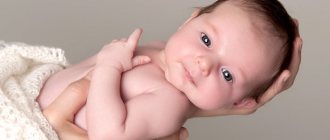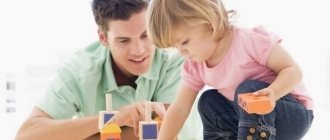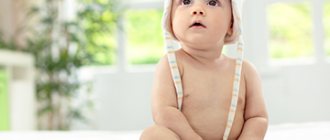After celebrating their child's first birthday, parents begin to think about how quickly time flies. And many of them get the idea that they shouldn’t miss precious moments. What mom and dad don’t give to their baby at an early age will be very difficult, and sometimes impossible, to make up for in the future. But how to develop a child at 1 year old? What needs to be done at this age so that the baby grows up not only smart, but also happy and carefree? How to maintain harmony and not go too far in the early development of a child? Let's try to understand this complex and important issue.
General norms for the development of children from one year of age
During this period of the baby’s life, his skills, which he acquired over the year, begin to improve. He begins to study the world around him with more and more interest. Naturally, he is still highly dependent on his parents, but despite this, the baby still strives to be independent and gradually develops his character.
Thus, the norms for this period in life are:
- The ability to independently slide and crawl onto steps, and with the support of parents to walk along the same stairs;
- It is great to crawl and gradually move from crawling to walking with the support of parents (it will be great if he is already taking steps on his own without you);
- Removes and inspects the contents of your drawers;
- Actively undertakes to explore the room and successfully climbs onto the available furniture;
- Begins to actively babble and say words, the meaning of which he already understands;
- Uses a spoon, toothbrush, cup, comb, etc. independently;
- The child eats thick food with a spoon;
- Recognizes loved ones by their faces and names without any problems;
- When the baby helps to dress himself;
- The child happily demonstrates his feelings: negative feelings or love;
- Positive attitude towards walks;
- Gradually begins to talk to his toys during play;
- When a child willingly carries out some instructions or instructions;
- After playing, puts the toys back in their place;
- Learn to draw little by little.
Mental, psychological and social achievements
Mental and psychological development is especially active in the period from one to two years. This is the age when, first of all, the speech of a small person develops well, as well as visual, auditory and tactile perception. A child up to two years old learns to understand spoken language, accumulates a passive vocabulary and begins to speak himself. At 12 months, a child’s vocabulary can be only 10 words, but after two years the baby already speaks 100 words well, and uses phrasal speech.
There are often cases when a child of one and a half years old speaks only a few simple words, such as mom, dad, baba, etc., and does not utter any new words until he is two years old. Often kids are simply too lazy to talk and are just accumulating vocabulary. At this age, the main thing is that the child understands what they want to tell him and fulfills the requests and instructions of adults. The main thing is to work with your child a lot and often, use different early development methods in games - and the baby will definitely start talking.
In the emotional and psychological development of a child after a year, there is a contradiction - at the same time, dependence on the mother and the desire for greater independence coexist.
The intellectual and social development of a child from 1 year to 14 months includes the following skills:
- The child can say simple, familiar words, for example, give, no, mom, dad, his name, etc.
- The baby “talks” a lot in his own language, which is still incomprehensible to adults.
- Vividly expresses positive emotions: laughs, laughs, shows warm feelings, i.e. kisses and hugs people close to him.
- Actively demonstrates character and will, expressing negative, negative emotions when dissatisfied or angry, while demanding something, he can shout, get irritated, stomp his feet, lie down on the floor.
From 1 year by months to one and a half years, the child’s psychological development becomes more and more active:
- The child’s passive and active vocabulary literally increases by months; he is already able to speak not just individual words, but also utter several simple phrases.
- The child is already familiar with the names of body parts and can, upon request, show them without errors.
- In the pictures, he can also choose the right item correctly, which indicates the development of the baby’s memory.
- Recognizes himself in the mirror and can say his name. He knows all his relatives by name and “position”.
- He strives to imitate the behavior of adults.
- Learns to listen to instructions from adults and distinguish between prohibitions.
- Begins to consciously control urination. A child should start potty training at one and a half years old.
After one and a half and up to two years, the baby’s intellectual and social skills improve more and more. For this age, the following development rates are determined:
- A two-year-old child already understands well the difference between what is permitted and what is not permitted, and knows exactly what is allowed and what is not allowed. Likes to perform prohibited actions in order to attract the attention of adults and observe their reaction.
- He understands adult speech well.
- A child’s speech increasingly contains simple phrases, and a new word can appear almost every day.
- The child can already explain in simple words his actions or the actions of others.
- If desired, answers questions and carries out assignments.
- A two-year-old child can already listen to an interesting story or watch a cartoon for 15 minutes to half an hour without a break.
- Orients himself well in familiar areas, in his apartment, on the playground, etc.
- An interest in small details appears, the child is attracted to screws, buttons, etc., thereby developing fine motor skills, which contributes to better speech development.
- Consciously asks to go to the potty or uses it independently.
- After one and a half years, a child’s taste preferences often change, and he may begin to refuse food that is familiar to him. At two years old, the baby himself strives to eat with a spoon and drink from a cup.
- He has a new interest in walking.
- After one year and up to two years, a child’s imagination changes, it becomes richer, but can cause unreasonable fears in relation to toys, the dark, etc.
- At this age, the child begins to miss his parents and relatives if he does not see them for a long time.
- Every month the child shows more and more persistence in achieving his goals, demonstrating character. The desires of a child at this age can be unacceptable, difficult to control, and difficult to “agree” with.
https://www.youtube.com/watch?v=DcK4Jc3RZLY
Developmental norms for a child from one year and three months to one year and six months:
After the baby reaches 15 months, he begins to move more variedly and confidently. It is during this period of his life that the child begins to walk independently, without the support of his father or mother, and he can also bend, back and turn on his own. At first it will be difficult to maintain your balance and you cannot do without falling. Therefore, it is necessary to insure the child so that he does not hurt himself, but give him the opportunity to walk on his own.
Try to encourage your child after each time he overcomes difficulties on his own. For example, if your child tries to walk on his own again after falling, encourage him with pleasant words rather than rushing to pick him up quickly. If you don't constantly help him, he will learn to keep his balance faster and stand on his own. This will be his great achievement.
Physical skills
The little fidget does not sit still, he can jump on the spot, jump over objects, and maintain balance when walking along the curb. He loves to dance, draws lines and ovals, and flips through the pages of a book.
Speech development
Playing together between mother and child contributes not only to the mental development of the baby, but also to the bonding between mother and baby.
Speech development in children noticeably accelerates after a year. Kids pronounce words correctly, repeat after their parents, and ask a lot of questions. They know the names of loved ones and their own name. Closer to 2 years old, they write a story about the past day. You can read how to teach a 2-year-old child to say the letter “R” here.
If your child’s speech is slurred and the pronunciation of sounds is clearly impaired, you should consult a doctor; your baby may have dysarthria.
Emotional development
The little man is inclined to rejoice at his good fortune; he cries if his request is denied. Expresses emotions when communicating with family, shows interest in other children.
Household skills
Daily routines teach the child to use a spoon, wash his hands, ask to go to the potty, and put on a hat and mittens.
Thinking
By the age of 2, the child can correctly assemble a pyramid, nesting dolls, and 4-piece puzzles. Names 8 colors, collects objects by shape, color, size. Knows circle, square, triangle.
Svetlana Vyacheslavovna Babko, pediatrician, head of the Children's Health Center at the FEFU Medical Center, Vladivostok
A child develops due to a combination of many factors. The task of parents is to create harmonious conditions for the development of their children.
Little children need love and affection. It’s not difficult to play with your baby, tell him about what interests him, read or sing a song together.
Children of this age are able to remember large amounts of information, repeat everything they see, and understand when it is explained to them.
If you are concerned about the development of your baby, you should contact a neurologist. An examination will show abnormalities, and the doctor will prescribe treatment and give recommendations. Consultation with a doctor is required if premature babies develop after one year.
During these three months, in addition to walking, the child should:
- Be able to bend over for a toy without sitting down;
- Easy to climb stairs, with a little parental support;
- Run, jump and spin in place;
- Step over the blocks with an extended step;
- Eat independently in addition to solid liquid food;
- Sit confidently in your place and be able to independently get off high furniture (sofa, chair, etc.);
- It's good to kick and throw a small ball, but misses are forgivable;
- Continue to open all the drawers and explore the room;
- It's not a bad idea to doodle in a sketchbook;
- Remember all the main parts of your body, and also perfectly remember pictures in a book and find them easily;
- Correctly name actions and objects that he already knows;
- Try to build different structures from construction sets, Legos, cubes or rings, and even be able to assemble them correctly.
A year and six months is already a big date for a baby, since he can already draw a conclusion to the beginning stage in his life.
All parents should be seriously concerned if their child:
- He is unable to utter a coherent word;
- Can't walk or hasn't even tried to;
- Cannot fulfill the simplest request;
- Plays simple games with some difficulty;
- Doesn't cry or worry when you're not around;
If you have observed such symptoms in your child, then he clearly has a developmental delay. In such a situation, you need to show the baby to a specialist as soon as possible so that he can help solve this problem and your child will be completely healthy.
What should you pay attention to at this age?
The age from one and a half to two years is still the age of the first tests for the intellectual and speech development of the baby. A child between 1 and 2 years of age should be seen by a doctor if he or she is unable to do the following:
- At the age of one and a half he did not start walking.
- After two years he does not speak a single word.
- At one and a half years old, he does not understand adult speech and does not fulfill simple requests.
- At two years old, he does not react for a long time to the absence of his mother or another adult who cares for him.
- At one and a half years old, he does not strive to play the simplest children's games.
These are very alarming symptoms that can mean both a delay in age-related development and signal problems with the child’s physical health. In this case, the child should be immediately shown to a pediatrician and child psychologist.
Norms of child development from 1.5 to two years
In the second year of his life, your child undergoes a serious change in the emotional sphere. He already stands quite confidently on his own feet without support, and this achievement opens up new spaces for the baby, who is ready for new adventures every day. During this period, the baby begins not only to get acquainted with the whole world around him, but also to reach out to other children.
In addition to all this, the child begins to learn the most basic rules of behavior and fulfill the requirements of adults.
The first three months of the child’s second year of life are characterized by the following norms of changes:
- He loves to jump;
- Confidently kicks and throws the ball up;
- Runs well and walks well (almost without stumbling);
- Calmly steps over or runs around an obstacle;
- Likes to dance and sing along to music or a song;
- Understands a short and simple story from a picture in a book quite well and even answers questions from adults;
- Starts to play with other children or adults;
- The child begins to show more demands and emotions.
If your baby cannot fulfill most of the requirements listed in the article, then you should not postpone a visit to the pediatrician, and also visit a child psychologist. In addition to medical consultation, try to pay more attention to your child and gradually teach him through educational games. Your support and warm love will help make up for lost time.
After a year, many brain processes are activated in a child. The development of a child after one year is characterized by the growth of the brain and cortex, and the processes of accumulation of information. The child begins to fully develop cognitive behavior and exploratory interests. The child is interested in all things in the environment: how they work, and most importantly, how they break. During this period, the child learns the hierarchy and relationships between relatives. The little man examines objects one by one. For example, he will ask why the grass is green until he has a clear understanding of the answer to this question in his head, then the child will move on to the next object. The formation of the native language and binding to the place of residence occurs.
Physiology of a 12-month-old baby
From the moment of birth, in 12 months the child almost triples his weight, and by the year he usually weighs 8-11 kg. At the same time, it grows by an average of 20-25 cm, reaching a height of 70-76 centimeters. A one-year-old baby, who usually already has 6-12 teeth, tends to chew solid food, which allows him to gradually stop grinding food. At this time, he can be switched to a more adult diet. At 12 months, moms typically wean their babies off the breast or formula bottle, ending breastfeeding/bottle feeding. At the same time, it is replaced with ordinary milk, cow's or goat's. At one year old, the child already needs less time to sleep; now he sleeps only once a day during the day, no more than one or two hours.
Educational cartoons for kids
As mentioned above, watching cartoons at such an early age is possible only in limited quantities. In order for cartoons to not only become a pleasure for a child, but also bring benefits, they need to be selected wisely. There are a huge number of them in modern rentals for every taste and age, but what educational cartoons for children 1-3 years old will really be useful?
Among the most popular are short stories: “Lev’s Truck”, “Auntie Owl”, “Turtle Aha-Aha”, “Tini Love”. In addition, cartoons will be useful to help you learn letters, colors, shapes, animals and the names of objects.
Baby to the masses
Yes, yes, the harmonious development of a baby is impossible without communication. By locking a child in an apartment and limiting his communication, it is impossible to expect great achievements from him. Of course, you can achieve intellectual development on your own; the child simply will have no choice but to do what his parents offer him.
However, the process of cognition occurs much faster and more naturally when the child is in society. This way he will be able to learn something useful not only from his beloved parents, but also from relatives and other children on the playground, in playrooms and early development centers.
A book is your best friend from the first days of life!
Instilling a love of reading in a very young child is much easier than in an older child. Modern publishing houses print excellent literature for very young children. Thick cardboard pages, large drawings with clear images and no small details are the requirements that books for children must meet. Well, the list of authors is very extensive:
- Elena Blaginina.
- Boris Zakhoder.
- Korney Chukovsky.
- Agnia Barto and many other wonderful children's writers.
Create!
At the time the baby learned to sit, a wonderful world opened up before him. He was able to look at his environment from a new angle, and the child became even more interested when he walked. A mother needs to constantly look for new sources of knowledge for her child, and creativity is an excellent help for this.
With a young child, you can also draw, sculpt, make appliqués and assemble construction sets, teach him how to compose images from mosaics and encourage his creative impulses in every possible way.
Developmental centers for children from 1 year old practice similar activities. Among those recognized by mothers are: “Rainbow”, “Mosaic”, “Anthill”. It is very important that a large amount of material has now been created for completely unintelligent children - these include non-toxic finger paints, kinetic sand, and safe plasticine. Many development groups practice modeling from salted dough colored with food coloring.
